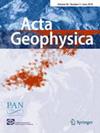一些铁和石质陨石的电特征及其与镍含量关系的初步研究
IF 2.1
4区 地球科学
Q2 GEOCHEMISTRY & GEOPHYSICS
引用次数: 10
摘要
本研究被认为是对陨石在变电流频率下的电特性的探索性研究,称为电特征。对一些铁陨石(Mundrabilla和Gibeon陨石)、石质陨石样品(NWA 869、NWA 7629和Ghubara)和已知Ni浓度的Fe-Ni合金样品在不同频率下的电阻率进行了测量,测量频率在1 ~ 100 KHz之间,这些样品已制备并用作与所研究陨石进行比较的标准。此外,还应用了EDX技术支持的SEM研究。SEM和EDX显示使我们能够获得研究样品的化学成分和内部结构织物。对这两种陨石的孔隙度和密度(体积和颗粒密度)也进行了测量。所研究陨石的孔隙度值很低(∅≤3%),对应于微孔洞和微裂纹。未风化样品的颗粒密度从石质陨石的3.48 g/cm3到铁陨石的7.91 g/cm3不等。所获得的电特征对每种类型都具有诊断性,并可用于定量检测Ni的浓度。石质陨石的电特征比铁陨石的电特征简单得多,在较高的镍浓度下也获得了更简单的电特征。本文章由计算机程序翻译,如有差异,请以英文原文为准。
A Preliminary Study On the Electrical Signatures of Some Iron and Stony Meteorites and Their Dependence On Nickel Content
The present study is considered as an exploratory study of electrical properties of meteorites at variable current frequencies, called the electrical signature. The electric resistivity has been measured at different frequencies, varying between 1 and 100 KHz for some iron meteorites (Mundrabilla and Gibeon meteorites), stony meteorite samples (NWA 869, NWA 7629 and Ghubara) and Fe-Ni alloys, of known Ni concentration, which have been prepared and used as standards to be compared with the studied meteorites. In addition, SEM studies supported by EDX technique have been applied. The SEM and EDX displays enabled us to obtain the chemical composition and internal structural fabrics of the studied samples. Porosity and density (bulk and grain densities) have also been measured for both types of meteorites. Porosity values of the studied meteorites are very low (∅ ≤ 3%) and correspond to micro vugs and cracks. The grain density of non-weathered samples varies from 3.48 g/cm3 for the stony meteorites to 7.91 g/cm3 for the iron meteorites. The obtained electrical signatures are diagnostic for each type and can be used to detect quantitatively the concentration of Ni. The electrical signature of stony meteorites is much simpler than that of iron meteorites, and simpler signatures have been obtained at higher Ni concentrations.
求助全文
通过发布文献求助,成功后即可免费获取论文全文。
去求助
来源期刊

Acta Geophysica
地学-地球化学与地球物理
CiteScore
3.90
自引率
13.00%
发文量
251
审稿时长
5.3 months
期刊介绍:
Acta Geophysica is open to all kinds of manuscripts including research and review articles, short communications, comments to published papers, letters to the Editor as well as book reviews. Some of the issues are fully devoted to particular topics; we do encourage proposals for such topical issues. We accept submissions from scientists world-wide, offering high scientific and editorial standard and comprehensive treatment of the discussed topics.
 求助内容:
求助内容: 应助结果提醒方式:
应助结果提醒方式:


